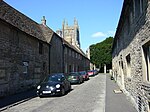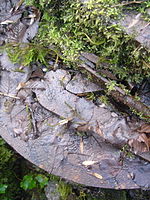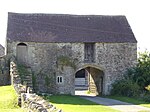Mells War Memorial

Mells War Memorial is a First World War memorial by Sir Edwin Lutyens in the village of Mells in the Mendip Hills of Somerset, south-western England. Unveiled in 1921, the memorial is one of multiple buildings and structures Lutyens designed in Mells. His friendship with two prominent families in the area, the Horners and the Asquiths, led to a series of commissions; among his other works in the village are memorials to two sons—one from each family—killed in the war. Lutyens toured the village with local dignitaries in search of a suitable site for the war memorial, after which he was prompted to remark "all their young men were killed".The memorial takes the form of a marble column topped by a sculpture of Saint George slaying a dragon, an image Lutyens used on two other public war memorials. At the base of the column, the names of the village's war dead are inscribed on stone panels. The memorial is flanked by identical rubble walls in local stone, on top of which grows a yew hedge. Low stone benches protrude from the walls to allow wreaths to be laid. Additional panels were fixed to the wall after the Second World War to commemorate that conflict. The memorial was unveiled on 26 June 1921 by Brigadier-General Arthur Asquith, whose brother is among those commemorated on it. It is a grade II* listed building and since 2015 has been part of a national collection of Lutyens' war memorials.
Excerpt from the Wikipedia article Mells War Memorial (License: CC BY-SA 3.0, Authors, Images).Mells War Memorial
Fairview,
Geographical coordinates (GPS) Address Nearby Places Show on map
Geographical coordinates (GPS)
| Latitude | Longitude |
|---|---|
| N 51.2409 ° | E -2.38933 ° |
Address
Fairview
BA11 3PP , Mells
England, United Kingdom
Open on Google Maps











